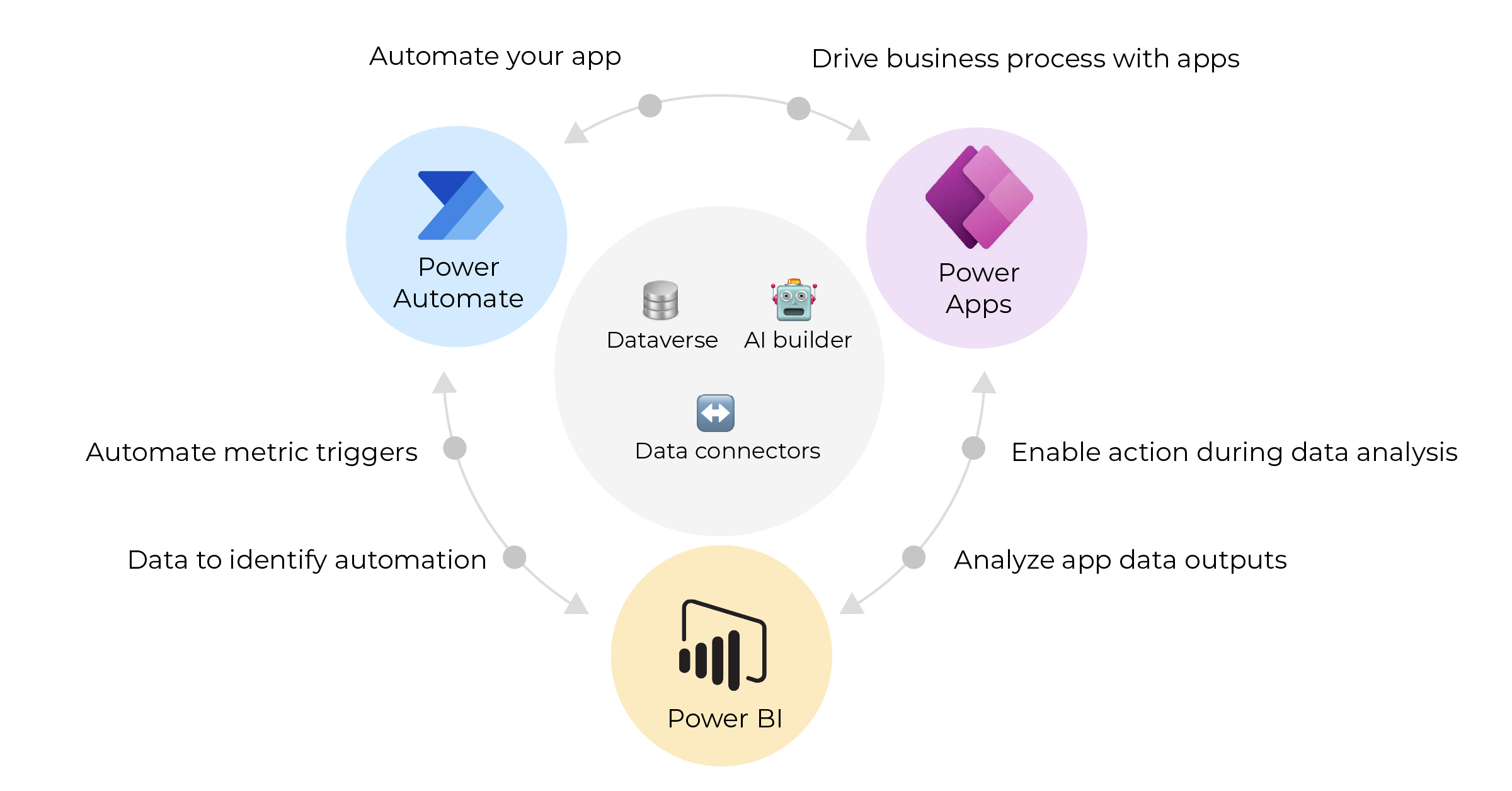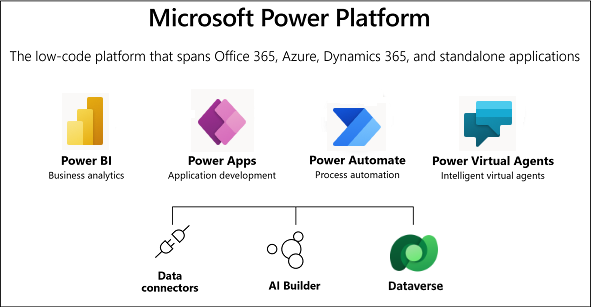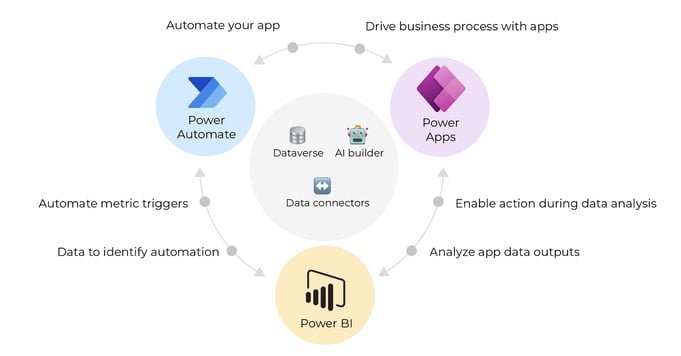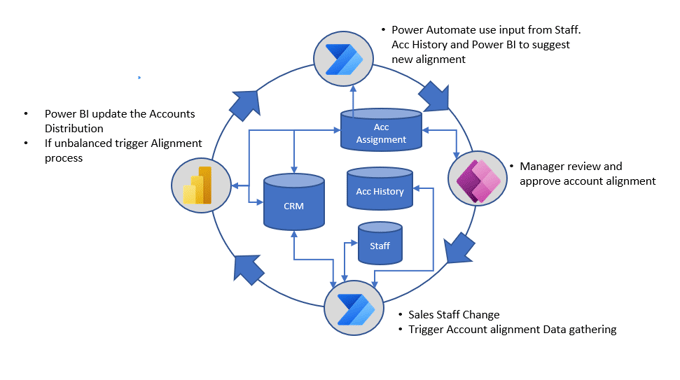
Family of Microsoft Products – 1+1+1 = much more than 3
Jun 7, 2022 10:55:38 AM
A Family of Microsoft Products – Why are they so important for your business?
You are likely to be familiar with how quickly Microsoft develop and releases new technologies, which can make it difficult to stay on top of potential products and solutions. However, the rapid pace of development opens your business up to a wealth of innovative software solutions, including the Power Platform family.
Historically, data analysis and automation with AI were solely reserved to highly skilled IT teams; however, the Power Platform family allows businesses with little to no coding knowledge to gain access to the valuable benefits of workflow insights and automations. All businesses are becoming increasingly reliant on data as a means to gain valuable insights and this is why the Power Platform is so exciting.
Why should my business use the Power Platform?
The pressure on cognitively skilled personnel is increasing, and at the same time, the availability of skilled labour is challenging at best. Microsoft Power Platform, especially Power Automate, can remove repetitive tasks and free up your current staff to do more meaningful taks. For more details on coming business challenges and why you should care - check out this short paper on the Perfect Storm Brewing.
The Power Platform is a collective term used to describe three core product components, Power Bi, Power Apps and Power Automate. Although each component provides its own individual benefits, it is the combined capabilities of manipulating, automating, analysing, and reporting on data from both Microsoft and third-party apps that is the greatest benefit.
Common Data Service (CDS) unifies the data within these apps to create a variety of interoperable services, which are capable of building highly effective automated workflows. In our latest blog, we take a closer look at this family of Microsoft products, how they combine, the benefits and which products could be the most beneficial to you as a business manager.
How do the products within the Power family work together?
Comparing the various components within the Power family can seem quite complex and overwhelming, it is possible to simplify this through illustrations, and when it comes to software components, there are many ways to illustrate the various links. These illustrations can take many forms; flow diagrams, pictograms, block diagrams, circular flows and even 3D illustrations; however, it is the detail that is being conveyed that will determine the most appropriate illustration.
For example, the Microsoft Power family of products includes 3 core components, Power BI, Power Apps and Power Automate. As you can see in Figure 1 below, these 3 components could be illustrated as a block diagram, but this does not convey the strength of the individual components when combined.

Figure 1 The 3 components of the Microsoft Power Platform family as a simple block diagram
It is not as straightforward as a simple calculation of 1 product + 1 product + 1 product = a family of 3 products, as the combined benefit of each component within the Microsoft Power family is far greater. Put simply, Microsoft Power Platform is far more than the sum of its parts!
For those who are only starting to familiarize themselves with this trio of products for the first time, the block diagram above may suffice, but for technical managers who are really looking to learn more about the potential benefits of the Power Platform, a higher level of detail is required.
If you search for illustrations on Google of the Microsoft Power family, many variations of diagrams are available, such as Figure 2 below. As you can see, this illustration also includes Power Virtual Agents as one of the components within the Microsoft Power Platform, which is also often referred to as a part of the Power Automate component.

Figure 2 Typical block diagram with the main components of the product family
It is worth noting how Figure 2 above introduces Data Connectors, AI Builder and Dataverse as sub-components within the Power Platform. This hierarchical block structure adds a new level of understanding to the simple 3 block illustration we first considered in Figure 1; however, it does not yet explain how these individual components actually interact to provide increased benefits to the end-user.
For this level of detail, a circular diagram such as Figure 3 below is more appropriate. As you can see, the outer circle includes the 3 main components which we are now familiar with, Power Automate, Power Apps and Power BI, with Data Connectors, AI Builders and Dataverse sub-components added to the centre of the diagram to illustrate how each of the components shares these products. The outer edge of this diagram shows exactly how each of the components interacts, with the continual flow of data important for each part of the Power Family.

Figure 3 A circular view of the Microsoft Power Platform that illustrates the interactions possible within the family of products.
As you can see from Figure 3 above, the power of this family of products is far greater when they are brought together than if they were to work alone, which is why in this scenario, 1+1+1 will always equal more than 3.
What are the main components of the Power Platform?
From the various figures above, we can see that three main components and technologies are central to the Power Platform capabilities; PowerApps, Power BI, and Power Automate.
1. PowerAppsPowerApps is a low code solution for the creation of custom apps, which allows users to connect to data from various business applications. It is designed to be very user-friendly, with only the information relating to the task in hand displayed via a popular drag and drop feature. The ability to create mobile applications for internal users could prove to very useful, especially when combined with the features available within other components of the Power Platform.
2. Power AutomatePreviously known as Microsoft Flow, this product allows users to create automated workflows between your business's various services and apps. This will help your staff avoid doing repetitive tasks, but it is also possible to reduce overheads, improve efficiency, and improve the quality of the various processes.
3. PowerBIThis is a highly effective business analytics tool that allows users to connect to a variety of data sources to produce visuals and actionable insights. By using natural language without the need for prior coding knowledge, it is easier than ever to find out more about your complex data and to improve your service provision.
To find out more detail about the capabilities of these core components, take a look at our detailed whitepaper ‘A managers guide to Microsoft Power Automate - A Part of the Microsoft Power Platform’.
What are the sub-components within the Power Platform?
The glue that makes the 3 main components interact effectively are 3 main components, the connectors, the AI Builder, which is the ability to add AI and ML to your solutions, and finally, the Dataverse is the common data model to allow interaction between the components and other external applications.
Connectors
To enable the individual components within the various figures above to work together, connectors are needed. The more connectors used within a system, the more complex the software system can be. Every connector will offer a particular form of functionality within an automation solution, and as new connectors are added, the Power Platform will gradually become more tailored to the bespoke application requirements of the business.
If you would like to find out more about connectors within this trio of products, take a look at our blog post, Why Microsoft Connectors Matter.
Dataverse – Previous CDS
As the name would suggest, Dataverse is the software that makes it possible to store data in a way that is scalable, secure, and shareable. Without Dataverse, the components within the Power Platform would not be able to interact, so it really is the backbone of the entire Power family.
With Dataverse, it is possible to enter information into PowerApps, which can then be used within Power Automate to modify and enrich the data, before being accessed within Power BI to analyze and report on this data. Referring back to Figure 3 above, we can see now just how important Dataverse is within the family and why it is positioned centrally in the diagram.
For example, imagine that you are a technical manager for a company that employs a large number of salespeople, who are each responsible for a large number of accounts. These individual accounts are very important, as they represent repeat business to the company. Now, imagine that a salesperson is resigning, which triggers an offboarding process, with various admin and payroll tasks to complete.
Naturally, this can become quite a complex and time-consuming process, especially when you consider the various tasks and technology requirements. A common example of this process is shown in Figure 4 below:

Figure 4: An example of an employee offboarding workflow
The steps in the above example may seem simple, however, when you dig a little deeper into each process, it is clear that there are many small steps and often multiple individuals required. For example, the account redistribution step could quickly become quite complex as various details need to be established, such as:
- Which accounts belong to the salesperson leaving the company?
- What was the revenue from these accounts?
- What is the forecast/potential future revenue from these accounts?
- Which account managers are currently available, and what is their current workload with accounts?
- How many times has an account changed between salespeople?
To accommodate these various steps efficiently, figure 5 below shows how Dataverse can be utilised to follow through the various interactions by connecting both systems and employees. Within this complex workflow are Power Bi, Power Automate and PowerApps, which are brought together to create a seamless and efficient flow; after all, the three components Power BI, Power APP and power Automate combined are far more powerful than if they were to be used alone.

Figure 5: The interactions and capabilities of Dataverse within an employee offboarding process
AI Builder
At the very heart of the Power, Platform is the ability to complete knowledge-based tasks, so the value of AI can never be underestimated. AI Builder is designed to support humans by completing and anticipating the most tedious processes. Within every business, there are likely to be tasks that do not require cognitive capabilities. Everything from recognising numbers within a text document to understanding the sentiment within an email will utilise the capabilities of AI Builder.
The AI Builder component is designed to use a variety of shared AI models and templates, which users can add directly into an automated flow within the Power Platform. There are so many potential uses, including the following:
- Understanding the sentiment of an email from your boss, so that you can respond to angry or urgent queries.
- Understanding whether a support email is related to finance, support, product delivery or is simply another junk email.
- Within trained models it is possible to read and extract details from documents such as PDF files and invoices.
As you can see from the examples above, it is clear that the combined capabilities of AI Builder alongside connectors and the various components within the Power Platform will provide highly effective opportunities for automated workflows. For more information on the sheer scale of potential automation capabilities, please refer to the whitepaper A managers guide to Microsoft Power Automate - A Part of the Microsoft Power Platform.
Which product should a business use when planning an automation?
If you are wondering which components within the Power family to use for your automation, there are a variety of factors to consider. Depending on your requirements, the following factors may be important to your specific business needs:
- Flexibility – If you need to be able to extract, share and use data from a variety of systems, a module approach to creating flows may be suitable. This functionality could include both cloud and on-premises connections, which are able to work with both modern and the old Legacy applications to accommodate different coding options.
- Scalability – If you are just getting started with automation, it may be important that the products you choose can be scaled easily without incurring large costs.
- Stability – Depending on your industry, it may be essential that your automations are highly stable with a high availability rate. In these situations, it is possible to create a monitoring system which is always running in the background to pick up potential issues.
- Security – Depending on the workflow process, it may be important to control access to certain parts of the flow, so being able to ensure that only those with permission to certain information gain access could prove essential.
- Extensibility – A modular approach to automating can be useful, with the addition of new extensions improving the capabilities of the system. In particular, AI Builder can provide advanced functions quickly, without the need for an in-house data scientist.
Reach out to NudgeIT today and embark on your automation journey!
If you are a manager thinking of beginning an automation journey, it is clear that the Microsoft Power family is the platform of products you need to streamline your company processes. The NudgeIT team are here to ensure your business gets off to a flying start by taking care of the details and designing the most effective solutions. To find out more or book your free one-hour automation consultation, reach out to the NudgeIT team today.
Submit a comment